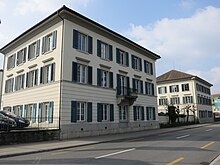Robert Schwarzenbach & Co
The Robert Schwarzenbach & Co AG was 1,829 in Thalwil ( Canton Zurich founded) and put silks ago. In 1928 Schwarzenbach was the largest textile company in the world with 28,000 employees and a turnover of 267 million Swiss francs, with a large part of the turnover being achieved in the USA.
history
In 1829 Johannes Schwarzenbach-Landis (1804–1861) went into business for himself as a silk manufacturer. In 1832, together with his father Joseph Schwarzenbach-Kölliker and his brother-in-law Jakob Näf-Schwarzenbach, he founded the Näf & Schwarzenbach silk weaving mill with its headquarters in the Aegertli district of Thalwil . The new place of business in two residential buildings (Ferggstube) on Seestrasse was expanded in 1846 with a silk winding and twisting mill.
In 1852 the business partners separated and Johannes Schwarzenbach-Landis founded Schwarzenbach-Landis & Cie. Ferggereien opened in Arn ( Horgen ), Männedorf and Greifensee , which paid the wages of the hand weavers and received the silk fabrics that they had produced on handlooms in their homework and most of which were exported. August Schwarzenbach (1834–1888), the eldest son, received procuration in 1856.
The mechanical silk weaving mill MSA was founded in Adliswil in 1860 with brother-in-law Emil Zürrer-Schwarzenbach ( Weisbrod-Zürrer ). After Johannes Schwarzenbach's death in 1861, his wife Anna Elisabetha inherited the business with her ten children, which was now run by Anna Elisabetha and their sons August and Robert (1839–1904). After the co-heirs left the business in 1868, August and Robert continued to manage and expand it as sole owners.
In 1870, around 1200 hand weavers were employed in Arn, Greifensee, Männedorf and Thalwil. In the following years, Ferggstuben were set up all over Switzerland and 2000 Lyon handlooms were given to the handicraftsmen: Hedingen, Bernese Jura (Laufen, Mervelier, Courroux), Rüti, Gaster, Höfe (Pfäffikon), Steinen, Einsiedeln, Stans, Lungern, Erlenbach.
In 1874 633,240 linear meters of silk fabrics with a sales value of 2.2 million francs were produced and sold. Own sales offices were founded in London, Lyon, Berlin, New York, Como and Milan from 1877. Jacquard weaving was introduced in 1880.
The economic crisis of 1873 led various countries to adopt protective tariff policies to protect their economies from the cheap imports of foreign competition. This forced the Swiss exporters to set up subsidiaries in their sales countries. The Schwarzenbach company founded the following subsidiaries: Italy (San Pietro-Seveso, Croce, Cadagno, Molin Prato San Pietro, Lecco, Castello), North America (Westhoboken, Union Hill, Bayonne, Altoona), France: (Boussie, La Tour du Pin) and Germany ( Hüningen 1897 today France, Wollmatingen 1907–1970 450 employees, Friedlingen 1922–1982 450 employees). In 1928 it developed into the largest Swiss group in the world and the largest textile company in the world, with its own skyscraper in Manhattan.
In 1884 the 3722 employees produced 2,619,460 linear meters of silk fabric with a sales value of 7.5 million francs. In the same year the construction of shed halls for the mechanical looms was started in order to be able to switch to the mechanical weaving mill.
After the death of August Schwarzenbach (1834–1888), the company was converted into the Robert Schwarzenbach & Co. general partnership in 1892. When Robert Schwarzenbach-Frölicher (1875–1929, Schwarzenbach, Huber & Co., New York), the eldest son, became a partner in 1899, the annual production was 5,139,000 running meters worth CHF 12.3 million and the employees were increased to 5595.
After the death of Robert Schwarzenbach (1839-1904), the sons Robert Schwarzenbach-Frölicher, Alfred Schwarzenbach-Wille (1876-1940) (lived on the Bocken Horgen estate from 1912 ) and Edwin Schwarzenbach-von Muralt took over the management.
The company managed to survive the First World War , the subsequent Great Depression and the Second World War , unlike many large industrialists. This was only possible thanks to ongoing adjustments to the development of technology, fashion, material (rayon, synthetic fibers) and the competition from the Far East as well as major financial sacrifices. In 1935 production had shrunk to less than ten percent.
Nonetheless, the factory had to be closed in 1981, only the trading company and the supplier manufacturing could be maintained. In 1983 the factories were demolished in favor of the Marbach housing estate.
Today the company holds real estate and particularly participates in companies in the textile industry. According to its statutes, the company should enable the company to run as a business for the Schwarzenbach family and their descendants.
literature
- Association for Economic History Studies Zurich (Ed.): Swiss Pioneers of Economy and Technology, Vol. 10, 1959
- Robert JF Schwarzenbach, The Schwarzenbach Enterprises , New York, 1917
- Fritz Hess: Thalwil in the 19th century, Zurich dissertation, 1938
- Hans Jakob Zwicky: Chronicle of the community Thalwil , 1995
- E. Vögtlin: To the Robert Schwarzenbach company on the occasion of the 1954 anniversary
- Lucerne University of Applied Sciences, Silk Memory: Schwarzenbach
- Lucerne University of Applied Sciences, Silk Memory: Mechanical silk weaving mill Adliswil MSA
Web links
- Christian Baertschi: Johannes Schwarzenbach. In: Historical Lexicon of Switzerland .
- Christian Baertschi: Robert Schwarzenbach. In: Historical Lexicon of Switzerland .
Individual evidence
- ↑ NZZ of September 23, 2011: Schwarzenbach Archive - A treasure trove is preserved
- ↑ Weil am Rhein: Global company Schwarzenbach
- ↑ Schwarzenbach Buildings, 470 Park Ave. South between 31st & 32nd Sts.
- ^ Andrea Keller, Thalwil Local Museum, 2004
- ↑ entry Robt. Schwarzenbach & Co AG, in Thalwil , daily register no. 1180 of January 8, 2010 in the Swiss Official Gazette of Commerce
- ↑ Thalwil's silk story goes to the archive . In: Tages-Anzeiger , February 8, 2011
Coordinates: 47 ° 18 '5.9 " N , 8 ° 33' 41.9" E ; CH1903: 684 930 / 239,581


